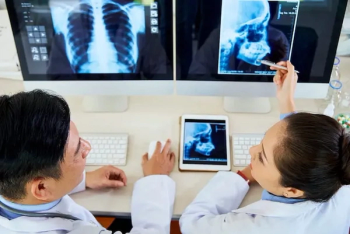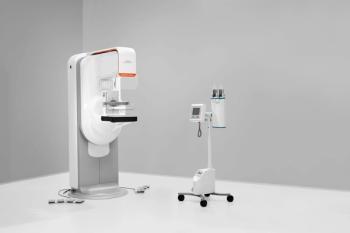
- Diagnostic Imaging Vol 30 No 11
- Volume 30
- Issue 11
Vendors polish advanced apps with 3T platforms
MR vendors have been chipping away at new clinical applications for years. They have pointed to 3T as the means to expand routine practice in ways that are not routine, adding computing engines to handle the massive volumes of data that would gush forth, expanding data pipelines, building out coils with extended channels-in short, creating the infrastructure to support a new diagnostic order. This year, they mean business.
MR vendors have been chipping away at new clinical applications for years. They have pointed to 3T as the means to expand routine practice in ways that are not routine, adding computing engines to handle the massive volumes of data that would gush forth, expanding data pipelines, building out coils with extended channels-in short, creating the infrastructure to support a new diagnostic order. This year, they mean business.
Breast imaging, oncology applications, and even, possibly, cardiac studies will be marquee applications next month on the RSNA exhibit floor. Siemens Medical Solutions began laying the groundwork for what it will show this year at the RSNA meeting with its introduction in 2003 of Tim, its Total imaging matrix. Tim CT is so named because the table moves as it does in CT for continuous scanning down the body to allow peripheral runoff MR angiography. A derivative to be showcased at this year's meeting will allow whole-body scanning to visualize primary tumors and aid staging of metastases.
Tim exemplifies the efforts by MR vendors to lay a foundation for product development based on powerful electronics, forging a multitude of integrated matrix coil elements and independent radiofrequency channels to support simple as well as complex neuro imaging studies; orthopedic and cartilage assessment; and breast, vascular, and cardiac exams.
Not since the heady days of the late 1980s have vendors been this excited about MR as the means for doing just about everything. Back then, pundits touted MR as a "onestop shop." But that characterization has long since faded. Extraordinary imaging of the heart, breast, and cancer require extraordinary technologies- specialty coils and tables, pulse sequences, and computing engines- and massive amounts of signal. This door has been opened by 3T.
Past gains in signal came at the expense of usability and productivity. Operators had to tweak sequences just so and moderate scan times just right to get the best image quality without depositing too much energy in patients. They performed a balancing act in which specific absorption rate (SAR) and reproducibility of results were the villains.
Philips Healthcare will bring out a new 3T "product innovation" that promises to fell these villains. The new 3T, which was unnamed at press time, will mark a "fundamental change in the way we acquire patient images," according to Deepak Malhotra, Philips vice president for marketing and strategy for MR.
"We believe it will take 3T to new levels of performance in terms of achieving consistency of results across a broad range of clinical applications, patient size, and raw imaging speed," he said.
In the past, 3T may not always have produced optimal results for certain clinical procedures, which has slowed the adoption of 3T by mainstream radiologists, according to Malhotra.
Breast imaging is an especially hot area for development, one that is well suited to 3T if the technology can be made user-friendly.
"One of our goals is to bring breast imaging to the mainstream in 3T, in addition to other clinical applications," Malhotra said.
Philips will complement its 3T efforts with its Elite breast package for both 1.5T and 3T scanners. The Elite breast option comprises breast imaging coils for diagnosis and biopsy, a specially designed MammoTrak table for patient positioning, and software for postprocessing.
"It will be soup to nuts for customers looking to get into breast imaging," he said.
GE Healthcare seeks to dispel concerns about 3T with its MR750. GE claims the new scanner, introduced in the spring at the International Society for Magnetic Resonance in Medicine meeting, allows up to five times better imaging performance than previous systems. The company claims that clinical studies can be performed much faster than before. Liver exams can be done in 15 minutes. Routine functional MRI and complete breast exams are possible in two sequences.
GE is positioning autocalibrating reconstruction for Cartesian sampling, its onboard parallel imaging system, as the way to reduce scan time and SAR in abdominal imaging and handle the magnetic susceptibility effects that often come from singleshot fast spin-echo sequences.
The MR750 will come with liver, brain (including stroke), and breast imaging applications, according to Jim Davis, vice president and general manager of GE's global MR business. "In addition, you will see new applications around noncontrast imaging techniques, as well as around susceptibility-weighted imaging techniques," he said.
These clinical gains hail back to inherent improvements in the system itself. The MR750's whole-body gradient system, composed of the newly developed eXtreme gradient module and driver, delivers 50 mT/m amplitude and 200 T/m/sec slew rate.
This compares with 45 mT/m amplitude and 150 T/m/sec slew using gradients onboard the current Signa HDx 3.0T. The net effect is a 60% increase in resolution, according to the company. A streamlined user interface cuts the number of steps by as much as 68%.
These and other time-saving enhancements reduce setup time in the scan room by up to 71%. A new thermal management system optimizes SAR and increases scan efficiency by 17%, according to GE estimates. "Every vendor is trying to settle the SAR and image quality issues," said Milind D. Dhamankar, senior director for MR product marketing at Siemens.
That company's 3T Verio addresses these issues, thanks to Tim and Siemens' TrueForm magnet and gradient designs, he said.
TrueForm optimizes homogeneity, according to the company, providing uniform RF distribution through all body regions. Verio, which the company introduced just prior to RSNA 2007, represents a new class of premium MR. With its 173-cm-long footprint and bore diameter of 70 cm, Verio is characterized by patient comfort but also high throughput and clinical reach, minimal operating costs, and siting advantages. The wide bore, bolstered by a 550-pound table capacity, allows for the diagnosis of obese patients.
Dotting the show floor will be other indicators of technological progress-advances in functional MRI, body diffusion-weighted imaging, and orthopedic protocols. Their success will be measured in what new software can do faster than before.
The common denominators of these advances are the eye-popping reconstructions that serve as visual proof of their clinical value. Not all of these will come from acquisitions made at 3T. At the GE booth will be two innovations running on its HD (high definition) xt platform, which includes both 3T and 1.5T. One, 3D Cube, captures submillimeter isotropic voxels that allow the viewing of volumetric data sets in any plane. Lesions as small as 2 mm can be visualized in reformatted data. The other, Ideal, obtains four images in a single acquisition. It improves image clarity through uniform fat suppression and handling of multiple contrasts from fat, water, and the fat-water combination, both in phase and out of phase. Ideal also reduces or eliminates artifacts due to chemical shift caused by metal implants, such as orthopedic screws or dental work, as well as those caused by misregistration between fat and water.
Both 3D Cube and Ideal were shown at RSNA 2007. They will be accompanied by additional clinical applications as GE continues to invest in the HDxt platform, Davis said. An undercurrent of this RSNA meeting will be cost pressures that have intensified in recent years with dwindling reimbursement. Again in the spotlight for Siemens will be its 1.5T Essenza, introduced last year in October along with the Verio. With a list price under $1 million, Essenza is Siemens' most affordable 1.5T MR, and the most affordable one for the whole MR industry, according to the company.
Just as image quality and price matter, so does patient comfort, according to Hitachi Medical Systems America, which hopes to woo its base of open MR faithful with the Oasis. This 1.2T open MR scanner, shown two years ago as a work-in-progress and released as a product earlier this year, will be the flagship of the Hitachi booth this year. The company argues that its Oasis provides a more open environment than competing systems through its unique design, an opening created by offsetting the poles that support the dual disks of the superconducting magnet. As the patient slides headfirst between the disks, which are completely open in front and back, the first pole to come into view on the right passes by the patient's line of sight before the pole on the left appears. This ensures that the patient always has an unobstructed view on one side.
The company has concentrated its initial installations in markets where owners have launched local TV, radio, and newspaper publicity campaigns. They have targeted physicians and patients, pitching the Oasis as "The Patient Magnet," a double entendre with special significance to a company whose fortunes rose and fell with market interest in open MR but whose commitment to this segment never wavered. Hitachi has installed more than 1500 MR systems in the U.S. and more than 3200 worldwide. Most are low- and midfield opens.
Another company that once hitched its star to open MR, Toshiba America Medical Systems, has since turned away from that segment, focusing instead on high-field systems. The firm has developed its 1.5T Vantage platform and, most recently, the wide-bore Titan, which is built on this platform.
Addressing concerns exemplified by the black box warnings on MR contrast agents, Toshiba America Medical Systems will focus on its portfolio of software that generates MR angiograms without the need for contrast.
"We will show a head-to-toe, easyto- use application," said John Hipple, senior product manager for MR at Toshiba America.
The company will also pay clinical homage to the applications that are galvanizing the industry, particularly breast MR.
"Breast imaging is a very big topic in MR," he said.
Articles in this issue
about 17 years ago
Multicenter trial confirmsvalue of coronary CT angioabout 17 years ago
Siemens tweaks PET/CT T with hybrid for radiologyabout 17 years ago
GE Healthcare seeks better image quality, lower doseabout 17 years ago
Tech advisor CT vendors plot strategies for growthabout 17 years ago
MRI spots anomalies in children with hearing lossabout 17 years ago
CT proves clinical worth in bowel obstruction casesabout 17 years ago
Strategies can limit imaging fungibilityabout 17 years ago
Smart probes and biomarkers spot earliest signs of cancerabout 17 years ago
MRA finds value in hydrocephalus interventionsabout 17 years ago
Carotid US predicts heart attack, strokeNewsletter
Stay at the forefront of radiology with the Diagnostic Imaging newsletter, delivering the latest news, clinical insights, and imaging advancements for today’s radiologists.




























